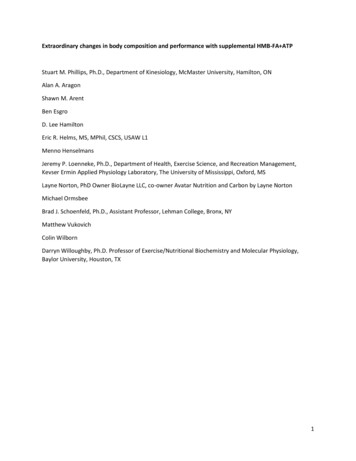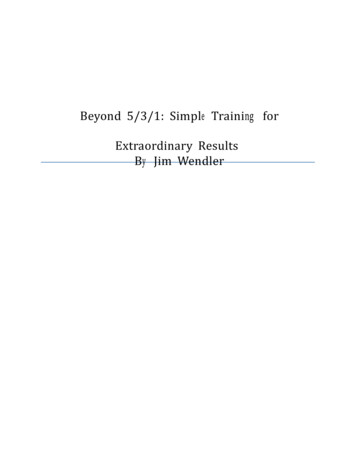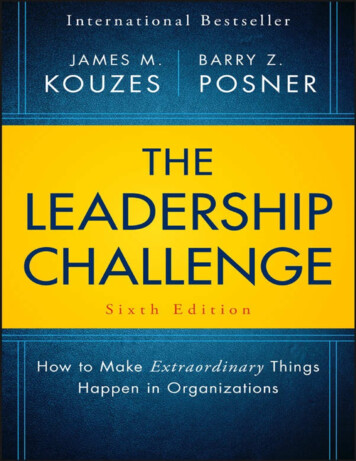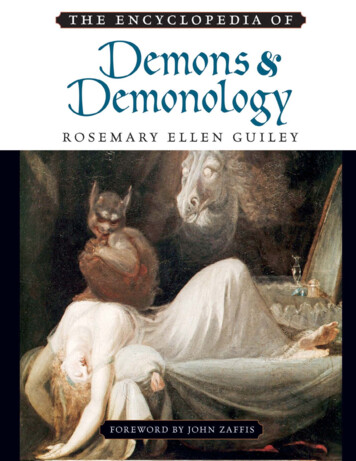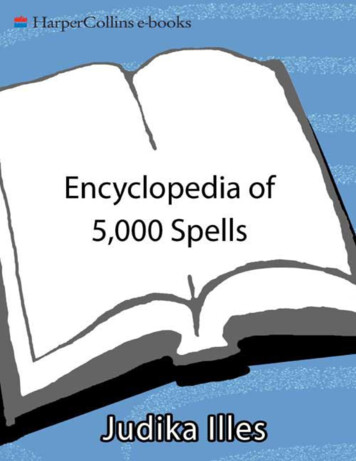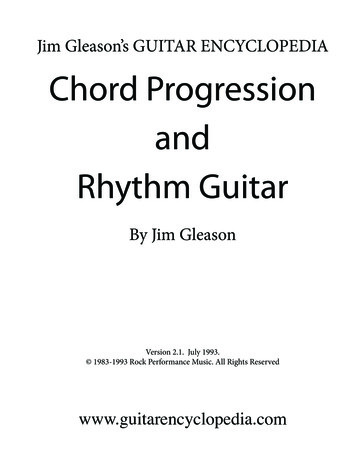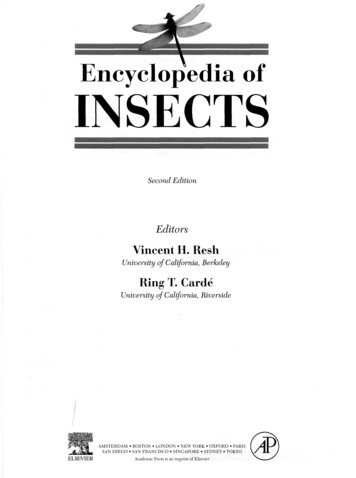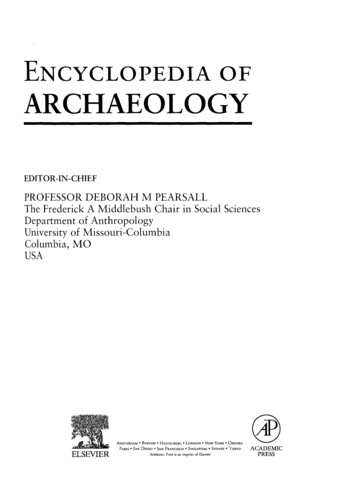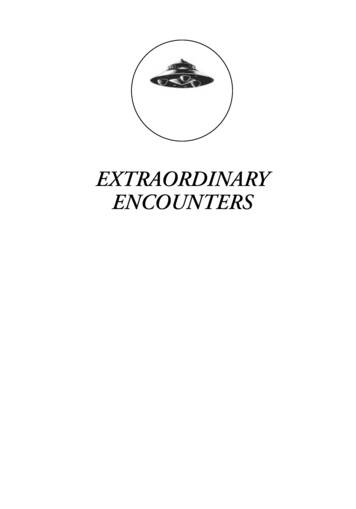
Transcription
EXTRAORDINARYENCOUNTERS
EXTRAORDINARYENCOUNTERSAn Encyclopedia of Extraterrestrialsand Otherworldly BeingsJerome ClarkBSanta Barbara, CaliforniaDenver, ColoradoOxford, England
Copyright 2000 by Jerome ClarkAll rights reserved. No part of this publication may be reproduced, stored in a retrieval system, or transmitted, inany form or by any means, electronic, mechanical, photocopying, recording, or otherwise, except for the inclusion ofbrief quotations in a review, without prior permission in writing from the publishers.Library of Congress Cataloging-in-Publication DataClark, Jerome.Extraordinary encounters : an encyclopedia of extraterrestrials andotherworldly beings / Jerome Clark.p. cm.Includes bibliographical references and index.ISBN 1-57607-249-5 (hardcover : alk. paper)—ISBN 1-57607-379-3 (e-book)1. Human-alien encounters—Encyclopedias. I. Title.BF2050.C57 ABC-CLIO, Inc.130 Cremona Drive, P.O. Box 1911Santa Barbara, California 93116-1911This book is printed on acid-free paper I.Manufactured in the United States of America.87654321
To Dakota Dave Hull and John Sherman,for the many years of friendship, laughs, and—always—good music
ContentsIntroduction, xiEXTRAORDINARY ENCOUNTERS:AN ENCYCLOPEDIA OF EXTRATERRESTRIALSAND OTHERWORLDLY BEINGSAngel of the Dark, 22Angelucci, Orfeo (1912–1993), 22Anoah, 23Anthon, 24Antron, 24Anunnaki, 24Apol, Mr., 25Arna and Parz, 26Artemis, 26Ascended Masters, 27Ashtar, 27Asmitor, 29Athena, 30Atlantis, 31Aura Rhanes, 34Aurora Martian, 34Ausso, 35Avinash, 36Ayala, 36Azelia, 37Back, 39Bartholomew, 39A, 1Abductions by UFOs, 1Abraham, 7Abram, 7Adama, 7Adamski, George (1891–1965), 8Aenstrians, 10Aetherius, 11Affa, 12Agents, 13Agharti, 13Ahab, 15Akon, 15Alien diners, 16Alien DNA, 17Aliens and the dead, 18Allingham’s Martian, 19Alpha Zoo Loo, 19Alyn, 20Ameboids, 21Andolo, 21Andra-o-leeka and Mondra-o-leeka, 21vii
viiiContentsBashar, 39Being of Light, 40Bermuda Triangle, 41Bethurum, Truman (1898–1969), 43Bird aliens, 44Birmingham’s ark, 44Blowing Cave, 45Bonnie, 47Boys from Topside, 47Brodie’s deros, 48Brown’s Martians, 50Bucky, 51Buff Ledge abduction, 52Bunians, 53Calf-rustling aliens, 55Captive extraterrestrials, 57Cetaceans, 58Chaneques, 58Channeling, 59Chief Joseph, 61Christopher, 61Chung Fu, 61Close encounters of the third kind, 62Cocoon people, 67Contactees, 68Cosmic Awareness, 72Cottingley fairies, 73The Council, 75Curry, 75Cyclopeans, 76Cymatrili, 76David of Landa, 79Dead extraterrestrials, 81Dentons’s Martians and Venusians, 87Diane, 87Divine Fire, 88Dual reference, 88Dugja, 90Earth Coincidence Control Office, 91Elder Race, 92Elvis as Jesus, 92Emmanuel, 93Eunethia, 94Extraterrestrial biological entities, 94Extraterrestrials among us, 95Fairies encountered, 99Fairy captures, 103Fossilized aliens, 104Fourth dimension, 104Frank and Frances, 105Fry, Daniel William (1908–1922), 105Gabriel, 107Gef, 107Germane, 111Goblin Universe, 111Gordon, 111Gray Face, 112Great Mother, 113Great White Brotherhood, 114Greater Nibiruan Council, 115Grim Reaper, 115Gyeorgos Ceres Hatonn, 117Hierarchal Board, 119Holloman aliens, 119Hollow earth, 121Honor, 123Hopkins, Budd (1931– ), 124Hopkins’s Martians, 125Hweig, 125Hybrid beings, 126Imaginal beings, 129Insectoids, 130Intelligences from Beyond (Intelligences duDehors), 130Ishkomar, 130J. W., 133Jahrmin and Jana, 133Janus, 134Jerhoam, 135Jessup’s “little people,” 135Jinns, 135Joseph, 136Kantarians, 139Kappa, 139Karen, 140Karmic Board, 140Kazik, 141Keel, John Alva (1930– ), 142Khauga, 143Kihief, 143King Leo, 144Korton, 145Kronin, 145Kuran, 145Kurmos, 146Kwan Ti Laslo, 146
ContentsLaan-Deeka and Sharanna, 149Lady of Pluto, 150Land beyond the Pole, 151Lanello, 153Laskon, 154Lazaris, 154Lemuria, 155Lethbridge’s aeronauts, 157Li Sung, 158Linn-Erri, 158Luno, 159Lyrans, 160Mafu, 161Magonia, 161Marian apparitions, 162Mark, 165Martian bees, 166Mary, 166Meier, Eduard “Billy” (1937– ), 167Me-leelah, 169Melora, 170Men in black, 170Menger, Howard (1922– ), 172Merk, 173Mersch, 173Metatron, 173Michael, 174Michigan giant, 175Migrants, 175Mince-Pie Martians, 175Miniature pilots, 177Monka, 177Mothman, 178Mount Lassen, 179Mount Shasta, 181Mr. X, 184MU the Mantis Being, 184Muller’s Martians, 185Noma, 187Nordics, 187Nostradamus, 188Octopus aliens, 191Ogatta, 191OINTS, 192Old Hag, 192Oleson’s giants, 194Olliana Olliana Alliano, 195Orthon, 195Oxalc, 196Oz Factor, 197Paul 2, 199Philip, 200Planetary Council, 200Portla, 201Power of Light (POL), 201Prince Neosom, 202Psychoterrestrials, 203Puddy’s abduction, 204R. D., 207Ra, 207Rainbow City, 207Ramtha, 209Ramu, 210Raphael, 211Raydia, 211Renata, 211Reptoid child, 212Reptoids, 212Root Races, 216Saint Michael, 217Sananda, 217Sasquatch, 217Satonians, 220Secret Chiefs, 220Semjase, 220Seth, 221Shaari, 222Shan, 222Shaver mystery, 223Shaw’s Martians, 226Sheep-killing alien, 227Shiva, 227Shovar, 228Sinat Schirah (Stan), 228Sister Thedra, 229Sky people, 232Smead’s Martians, 233Smith, 233Source, 234SPECTRA, 234Springheel Jack, 235Sprinkle, Ronald Leo (1930– ), 236Star People, 237Stellar Community of EnlightenedEcosystems, 238Strieber, Whitley (1945– ), 238ix
xContentsSunar and Treena, 239Tabar, 241Tawa, 241Tecu, 241Thee Elohim, 242Thompson’s Venusians, 242Tibus, 244Time travelers, 244Tin-can aliens, 245Tree-stump aliens, 245Tulpa, 245The Two, 246Ulkt, 249Ultraterrestrials, 249Ummo, 249Unholy Six, 252Vadig, 253Val Thor, 254Valdar, 255Van Tassel, George W. (1910–1978), 255Vegetable Man, 256Venudo, 257Villanueva’s visitors, 257VIVenus, 258Volmo, 259Walk-ins, 261Walton’s abduction, 261Wanderers, 266White Eagle, 266White’s little people, 266Wilcox’s Martians, 267Williamson, George Hunt (1926 –1986), 268Wilson, 270Xeno, 273Yada di Shi’ite, 275Yamski, 275Y’hova, 276Zagga, 277Zandark, 277Zolton, 277Index, 279
Introductionto keep in mind these wise words from scientist and author Henry H. Bauer: “Foolishideas do not make a fool—if they did, wecould all rightly be called fools.”Most of us believe in at least the hypothetical existence of other-than-human beings,whether we think of them as manifestations ofthe divine or as advanced extraterrestrials. Atthe same time most of us do not think ofthese beings as intelligences we are likely toencounter in quotidian reality. God and theangels are in heaven, spiritual entities whoexist as objects of faith. Extraterrestrials,though not gods, “exist” in much the sameway, as beings who science fiction writers andscientists such as the late Carl Sagan theorizemay be out there somewhere in deep space,though so far away that no direct evidencesupports the proposition. When devout individuals report feeling the “presence of God,”they usually describe a subjective state that thenonbeliever does not feel compelled to takeliterally.Of course we know there was a time whenour ancestors were certain that otherworldlybeings of all sorts walked the world. Godscommunicated openly with humans. Onecould summon up their presence or encounterthem spontaneously. Fairies and other supernatural entities haunted the landscape asExtraordinary encounters have been reportedfor as long as human beings have beenaround, and they are richly documented inthe world’s folklore and mythology. A full accounting of traditions of otherworldly beliefwould easily fill many fat volumes. This book,however, is not about traditions but about experiences, or perceived experiences, of otherworldly forces as claimed by a wide range ofindividuals over the past two centuries (withthe rare look farther back if the occasion callsfor it). In other words, it is about things thatpeople, many of them living, say happened tothem, things far outside mainstream notionsabout what it is possible to experience, but, atthe same time, things that seem deeply real toat least the sincere experients (that is, thosepersons who have had the experiences). Noteveryone, of course, is telling the truth, andwhen there is reason to be suspicious of thetestimony, that consideration is noted.Mostly, though, I let the stories tell themselves; I have left my own observations andconclusions in this introduction. Thoughmuch of the material is outlandish by any definition, I have made a conscious effort to relate it straightforwardly, and I hope readerswill take it in the same spirit. No single person on this earth is guiltless of believing something that isn’t so. As I wrote this book, I triedxi
xiiIntroductionthings that existed not just in supernatural belief but in actual experience. We also knowthat our poor, benighted ancestors knew nobetter. Superstitious, fearful, deeply credulous, they mistook shadows and dreams fordenizens of realms that had no reality beyondthe one ignorance and foolishness assigned it.Finally, most of us are aware, even if onlydimly so, that a handful of people in our ownenlightened time make more or less publicclaims that they have personally interactedwith supernormal beings. Such persons arethoroughly marginalized, treated as eccentricand novel, as different from the rest of us; ifthey are not lying outright, we suspect, theyare suffering from a mental disturbance ofsome kind. And we may well be right, at leastin some cases. As for the rest, we could not bemore mistaken.As it happens, reports of human interaction with ostensible otherworldly beings continue pretty much unabated into the present.They are far more common than one wouldthink. The proof is as close as an Internetsearch, through which the inquirer willquickly learn that material on the subject exists in staggering quantity. A considerable portion of it is about channeling (in which an individual is the passive recipient of messagesfrom the otherworld, usually speaking in thevoice of an intelligence from elsewhere) froma wide assortment of entities: nebulous energysources, soul clusters, extraterrestrials, ascended masters, interdimensional beings, discarnate Atlanteans and Lemurians, naturespirits, even whales and dolphins. Besidesthese purely psychic connections with theotherworld, there are many who report directphysical meetings with beings from outerspace, other dimensions, the hollow earth,and other fantastic places. Not all of theseideas are new, of course. The hollow earth andits inhabitants were a popular fringe subject innineteenth-century America, and in the latterhalf of that century, spiritualist mediumssometimes communicated with Martians oreven experienced out-of-body journeys to thered planet. In 1896 and 1897, during whattoday would be called a nationwide wave ofunidentified flying object (UFO) sightings,American newspapers printed accounts oflandings of strange craft occupied by nonhuman crews of giants, dwarfs, or monsters presumed to be visiting extraterrestrials.But in the UFO age—that is, the periodfrom 1947 to the present, when reports ofanomalous aerial phenomena became widelyknown and their implications much discussed—a small army of “contactees,” recounting physical or psychic meetings withangelic space people, has marched onto theworld stage to preach a new cosmic gospel. Ina secular context, UFO witnesses with no discernible occult orientation or metaphysicalagenda have told fantastic tales of close encounters with incommunicative or taciturnhumanoids. Some witnesses even relate, underhypnosis or through conscious “recall,” traumatic episodes in which humanoids tookthem against their will into apparent spacecraft. The early 1970s, the period when mostobservers date the beginning of the New Agemovement, saw a boom in channeling—againnothing new (spirits have spoken through humans forever) but jarring and shocking to rationalists and materialists. The same decadespawned such popular occult fads as theBermuda Triangle and ancient astronauts(prehistoric or early extraterrestrial visitors),based on the notion of otherworldly influences—benign, malevolent, or indifferent—on human life.As cable television became ubiquitous, television documentaries or pseudodocumentaries (some, such as a notorious Fox Networkbroadcast purporting to show an autopsy performed on a dead extraterrestrial, were thinlyconcealed hoaxes) served to fill programmingneeds and proved to be among cable’s mostpopular offerings. Books alleging real-life encounters with aliens, such as WhitleyStrieber’s Communion: A True Story (1987),fueled interest and speculation. In the 1990sPulitzer Prize–winning Harvard Universitypsychiatrist John E. Mack, who had hypnotized a number of persons who thought they
Introductionmay have encountered UFO beings, championed the idea—which not surprisingly generated furious controversy and even a failed effort to have him removed from his job—thatwell-intentioned extradimensional intelligences are helping an unprepared humanity toenter a new age of spiritual wisdom and ecological stewardship. Mack, along with otherprominent investigators of the abduction phenomenon such as Budd Hopkins and DavidM. Jacobs, pointed to the results of a 1992Roper poll as evidence that as many as 3.7million Americans have been abducted—aconclusion many critics, including some whoare open-minded about or even sympatheticto the abduction phenomenon, would dispute. Still, there seemed no doubt, based onthe experiences of investigators who havefound themselves inundated with reports, thatthousands of otherwise seemingly normal individuals believe themselves to be abductees.The abduction phenomenon is undoubtedly the most recent manifestation of the otherworldly-beings tradition, but older beliefsand experiences, though eclipsed, continue.Even into the 1990s, encounters with fairies—which extraterrestrial humanoids were supposed to have supplanted in the imaginationsof the superstitious and impressionable, according to any number of skeptical commentators—were noted on occasion. At least onerecent book from a reputable publisher—JanetBord’s Fairies: Real Encounters with Little People (1997)—argued that such things are a genuine aspect of a universe “so complex that wecannot begin to understand it.” The BlessedVirgin Mary appeared, as usual, all over theworld, as did other sorts of divine entities.The world, of course, goes on with its business as if none of this were true, taking serious(as opposed to tabloid) note only when beliefin otherworldly beings goes horrendouslywrong and thirty-nine cult members commitsuicide while awaiting the arrival of a spaceship following a comet. The March 1997mass death in San Diego of the faithful ofHeaven’s Gate (a contactee-oriented groupthat, in various incarnations, had existed sincexiiithe early 1970s) sparked big headlines even insuch august media as the New York Times andthe Washington Post. In the wake of thetragedy came all the predictable lamentationsabout alienation and irrationality in a worldthat more and more seems to have lost itsbearings. But the San Diego incident, although hardly unprecedented (history recordsnumerous episodes of group suicides committed in the name of otherworldly powers), wasanomalous in one important sense: few whohold such extraordinary beliefs, including theconviction that they personally interact withbeings from other realms, harm themselves orothers. In fact, most incorporate their experiences into lives so seemingly ordinary thattheir neighbors, unless told directly (whichthey usually are not), suspect nothing.In the late 1970s, when I lived in a NorthShore suburb of Chicago, I met a likable, generous-hearted family man named Keith Macdonald. Macdonald recounted a UFO sighting (also witnessed by his family) after whichhe felt that something had taken place that hecould not consciously recall. Under hypnosis,he described what would later be judged arather ordinary abduction experience: grayskinned beings took him into the UFO andsubjected him to a physical examinationagainst his wishes. The experience, if that iswhat it was, frightened him severely. For atime I lost touch with Keith. When I next sawhim, he told me he had been hearing mentalvoices and channeling messages from a planetcalled Landa, populated by wise, spirituallycommitted beings who looked like Greekgods and goddesses. Keith had learned that hewas originally from that planet but had gonethrough many earthly incarnations so that hecould lead the Earth as it entered a period ofturmoil and destruction before the ships fromLanda arrived to save the elect. Over the yearsI monitored Keith’s emerging beliefs and satin on a few—to me unimpressive—channeling sessions during which the all-wise David,his father on Landa, spoke on a level of verbaland intellectual sophistication that exactlymatched Keith’s.
xivIntroductionThough I never for a moment believed inthe literal reality of “those of Landa,” as theycalled themselves in their characteristicallystilted syntax, I was struck by a number ofthings. One was the almost staggering complexity of the cosmos Keith had conjured upin his imagination—the only place that Icould believe such a cosmos existed, with itsmany worlds, peoples, religions, politics, enmities, and alliances. None of it, I should add,was anything somebody could not have madeup, consciously or unconsciously. But all of itwould have done credit to a gifted writer ofscience fiction. Though he possessed a keennative intelligence, Keith was neither a writernor a reader. He did, however, have some previously existing interest—not profound orparticularly well informed, in my observation—in UFOs, the paranormal, and the occult. As I listened to him over many hours, Ibegan to feel as if somehow in his waking lifeKeith had tapped into the creative potentialmost of us experience in our dreams. As wedoze off to sleep and dream, images begin towell up out of the unconscious; in no morethan a moment we may find ourselves inundated with psychic materials sufficient to fill afat Victorian novel. When our eyes open inthe morning, all of that, alas, is gone. Keithhad the capacity, it seemed to me, not only tolive inside his dreams but to keep them stableand evolving.Only once, when asked outright, did I acknowledge my skepticism. The confession wasmoot because Keith had inferred as much frommy noncommittal responses to his typically excited revelations about the latest from the Landanians. He had no doubt—well, maybe 98percent of the time he had no doubt—that hewas in the middle of something real in themost fundamental sense of the word. He alsounderstood that he had no proof that wouldsatisfy those who, like me, found the Landanians’ word insufficient. Therefore, he continually implored the Landanians to provide himthat proof, and in turn they regaled him with aseries of prophecies, often about explosiveworld events (bloody uprisings, devastatingearthquakes), none of which came true; then,as if to add insult to injury, their rationalizations for the failure of the prophecies to be fulfilled bordered on, and sometimes surpassed,the comical. The prophecies and promises continued in a steady stream until Keith’s premature death in 1999, and his closest friend toldme that even at the end, Keith’s faith had notfaltered.Perhaps the most amazing aspect wasKeith’s manifest sanity, which he never lostthrough the many ups and downs of his interactions with the Landanians (not to mentionthe literally crippling health problems he suffered at the same time). He worked—as agarage mechanic in a Waukegan, Illinois, cardealership—until he was physically incapableof doing so any longer. He was a good husband to his wife, a good father to his twoboys, and a good friend to those who werelucky enough to claim him as a friend in turn.His children, in their teens at the initiation ofKeith’s adventures with Landa, and his wifevividly recalled the original UFO sightingthey too had experienced and Keith’s conviction that, after they had gone to bed and hehad continued watching the object, something had happened. Still, they did not believemuch in Landa, and his older son told meonce of his certainty that his father’s communications were psychological in origin. Yetthey loved him, and only those very close tohim had any idea that at any given moment agood portion of Keith’s attention was focusedon a world far, far away from the small suburban town where he spent much of his adultlife.In 1985, I flew in a private plane withKeith and two others (both, incidentally, convinced of the literal truth of Keith’s messages)to the Rocky Mountain Conference on UFOInvestigation, held every summer on the campus of the University of Wyoming in Laramie.The title is something of a misnomer; only arelative few who attend can be called “investigators.” The emphasis is on experience notjust with UFOs but with the space peoplewho fly them. The bulk of the attendees—the
Introductionnumber ranges from a few dozen to as manyas two hundred from year to year—are in regular contact with benevolent extraterrestrials.The aliens communicate through channeling,automatic writing (in which information isdictated to an individual from allegedly unearthly beings), dreams, visions, or voices inthe head, or they are perceived as if physicalentities. (I use this last phrase deliberately; onclose questioning, the individuals involvedusually turn out to have a fairly elastic definition of the infinitive “to see” in all its permutations.) Few of the contactees assembled inLaramie matched the stereotype of the flamboyant charlatan or nut case. A few—such asa young Japanese woman whom space friendshad guided to the United States in pursuit ofher mission for them—had traveled some distance. Except for the small detail of their associations with extraterrestrials, most were decent, ordinary local folk. The majority werefrom the small towns, ranches, and farms ofthe Great Plains, the sort of people to whomthe phrase “salt of the earth” is often applied.Among his own at last, Keith could nothave been happier. If he noticed that no oneelse spoke of Landa and its impossible-tooverlook plans for the Earth’s future, or thatevery other contactee had his or her specialspace friends, all with their own individualhard-to-overlook plans for the Earth’s future,he never said a word about it to me.Of course, nothing is as simple as wewould like it to be, and as I look back on theepisode, I realize that I will never know why“those of Landa” called on Keith. Not that Ihad any difficulty understanding who theywere. However tangled some of the details,there was no mistaking their underlying banality or their all-too-apparent shallow earthiness, with their Greek togas, pretentiouslyfractured English, and (yes) Roman Catholicfaith. They themselves were not that interesting; what made them worthy of attention andreflection was this curious paradox: to theman who had (unwittingly) created them,they had a nearly certain independent reality;to virtually any independent observer, therexvcould be no question of who had broughtthem (for whatever reason) into the worldand to whom they owed what passed for anexistence.Yet Keith was not crazy. Nor, according topsychological surveys of other space communicants who attend the Laramie conferences,are his fellows. The evidence from this andother psychological inventories tells us that wecan be mentally well and yet hold beliefs—and, more dramatically, have vivid experiences—that are far outside the mainstream,far outside our conventional understanding ofthe possible. In a book-length survey of outof-ordinary perceptions, three well-regardedpsychologists observe, “Notwithstanding thepresence of anomalous experiences in casestudies of disturbed individuals, surveys ofnonclinical samples have found little relationship between these experiences and psychopathology” (Cardena, Lynn, and Krippner,2000, 4). The authors stress that psychotherapists must understand the difference if theyare to treat their clients effectively. Psychological research into extraordinary encounters ofthe sort with which this book is concerned isin its infancy.Still, to anyone who looks carefully at thetestimony regarding otherworldly contacts, itbecomes apparent that such phenomena donot arise from a single cause. There is, for example, little in common between the averagechanneler and the average witness to a closeencounter of the third kind (a UFO sightingin which, according to a classification systemdefined by the late astronomer and ufologist J.Allen Hynek, “the presence of animated creatures is reported” [1972, 138]). Typically,channelers have had a long history of occultinterests before they begin communicatingwith supernatural entities holding forth on familiar metaphysical doctrines. Close-encounter witnesses, on the other hand, fit the profileof witnesses to less exotic UFO sightings; inother words, they are pretty much indistinguishable from their fellow citizens.Consequently, channelers look more likecandidates for subjective experience, and in-
xviIntroductiondeed to every indication channeling is justthat. It is not veridical (that is, independentlywitnessed or otherwise shown not to be a subjective experience); no channeling entity canprove its existence, and the information provided through the channeling process is susceptible to neither verification nor falsification. The “authority” of the channeling entityrests solely on its self-identification. If you believe he, she, or it is a discarnate Atlantean,space alien, or ascended master, you will believe what he, she, or it has to say. If youchoose not to believe any of that, the channeling entity will prove helpless to get you tochange your mind. Experiences such as closeencounters, conversely, may be veridical in thesense that on occasion they involve multiple—or, more rarely, independent—observers. In the case of multiply witnessed close encounters, subjective explanations are appliedonly with difficulty. An investigator in searchof an explanation has limited choices, usuallythree: (1) the claimants made up the story; (2)they naively misperceived what were in factconventional stimuli; or (3) they underwentan extraordinary experience that defies currentunderstanding.Between the extremes is a broad range ofnonexperiential material, a modern folklore inwhich the world and the cosmos are reinvented on the basis of believed-in but undocumented (and often, to those who care aboutsuch things, certifiably false) allegations. Mostpersons who circulate such stuff are sincere,but some of those who feed the stuff to themare not. Hoaxers provide documents, such asthe supposed diary attesting to Adm. RichardE. Byrd’s voyage into the hollow earththrough a hole at the North Pole, that believers cite to prove their cases. Most observersbelieve James Churchward’s famous (or notorious) books on the alleged lost continent ofMu are literary hoaxes—Churchward wasnever able to produce the ancient documentson which he asserted he had based his work—but earnest occultists and New Agers cite hisbooks as overwhelming evidence that Mu(more often called Lemuria) was a real place.Of course, embellishments grow on top ofembellishments, and every legend of a place, aworld, or a realm that is home to otherworldlybeings evolves and has its own rich history.Atlantis, for example, began as an advancedcivilization for its time, but by our time itspeople had come to be seen as advanced evenbeyond us, the creators of fantastic technologies and even the recipient of knowledge fromextraterrestrial sources. The hollow earth ofJohn Cleves Symmes (1779–1829) is not thehollow earth of Walter Siegmeister (a.k.a.Raymond W. Bernard, 1901–1965), anymore than the imagination of one century isthe imagination of the century that follows it.Flying saucers were not part of Symmes’sworld; consequently, they did not exist in hishollow earth. By the time Siegmeister wroteThe Hollow Earth (1964), no alternative-reality book could lack flying saucers.It is entirely likely that nothing in the bookyou are about to read will tell you anythingabout actual extraordinary encounters andotherworldly beings. If such exist, however, itis not beyond the range of possibility thatsomewhere amid the noise of folklore, belief,superstition, credulity, out-of-control thinking, and out-of-ordinary perception a signalmay be sounding. If so, it is a faint one, indeed. The world has always been overrun withotherworldly experiences, some of which certainly appear to resist glib accounting; yet sofar it has proved exasperatingly tricky to establish that otherworldly experiences are also otherworldly events. The otherworld, perhaps,can happen to any of us at any time, but wemay not live in it—at least if we know what’sgood for us—in the way that we live enclosedwithin the four walls of the physical structurein which we read these words. It is not wise topass through a world of physical laws whiledistracted by all-encompassing dreams. Evenso, there is still a nobility to dreaming. There isalso an undying appeal to the sort of romanticimpatience that imagines new worlds biggerand more wondrous than our own, then
Introductionbrings these worlds and their marvelous inhabitants into our own. If extraordinary encounters are occurring only with otherwise hiddensides of ourselves, they are still—or surely allthe more so—worth having.—Jerome ClarkxviiReferencesCardena, Etzel, Steven Jay Lynn, and Stanley Krippner, eds., 2000. Varieties of Anomalous Experience:Examining the Scientific Evidence. Washington,DC: American Psychological Association.Hynek, J. Allen, 1972. The UFO Experience: A Scientific Inquiry, p.138. Chicago: Henry RegneryCompany.
EXTRAORDINARYENCOUNTERS
AAception. They also learned “Cosmic Language—which is expressed simply by symbolsof various forms and colors, so that meaningsare the same in any language” (Anchor, 1958).Grevler had other space adventures. Onewas a visit to a depopulated, destroyed planet,the dreary result of science gone amok.“A” is the pseudonym Ann Grevler (a writerwho uses the pen name “Anchor”) gives theVenusian whom she allegedly e
Allingham’s Martian, 19 Alpha Zoo Loo, 19 Alyn, 20 Ameboids, 21 Andolo, 21 Andra-o-leeka and Mondra-o-leeka, 21 Angel of the Dark, 22 Angelucci, Orfeo (1912–1993), 22 Anoah, 23 Anthon, 24 Antron, 24 Anunnaki, 24 Apol, Mr., 25 Arna and Parz, 26 Artemis, 26 Ascended Masters, 27 Ashtar, 2
